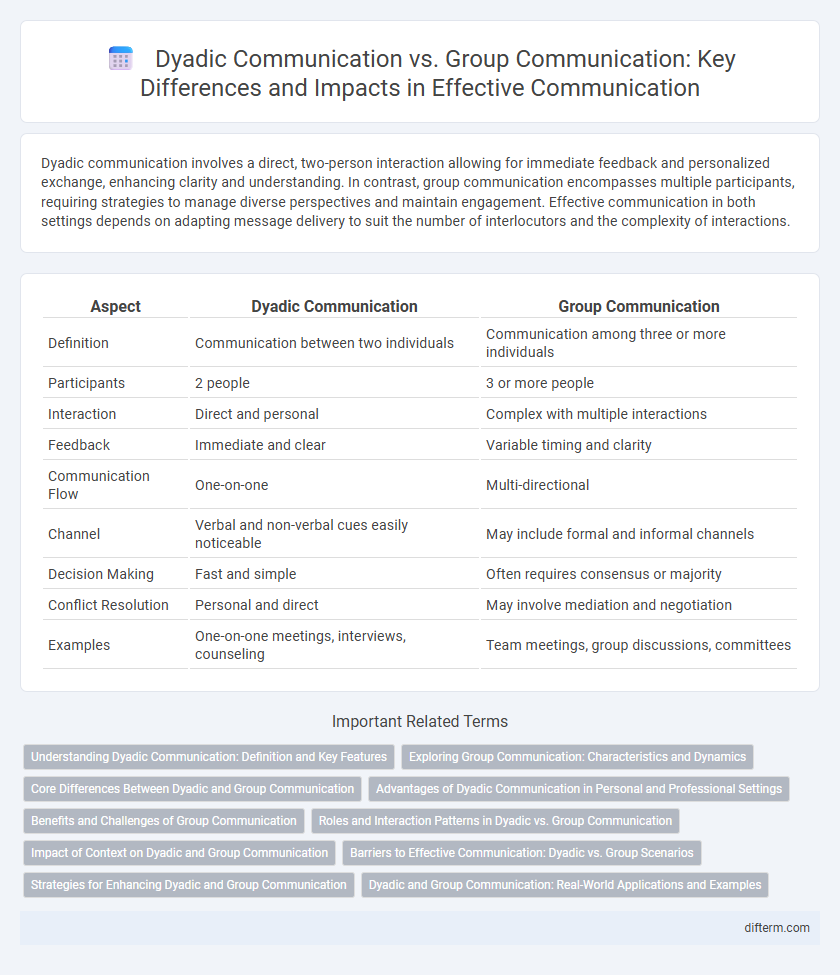Dyadic communication involves a direct, two-person interaction allowing for immediate feedback and personalized exchange, enhancing clarity and understanding. In contrast, group communication encompasses multiple participants, requiring strategies to manage diverse perspectives and maintain engagement. Effective communication in both settings depends on adapting message delivery to suit the number of interlocutors and the complexity of interactions.
Table of Comparison
| Aspect | Dyadic Communication | Group Communication |
|---|---|---|
| Definition | Communication between two individuals | Communication among three or more individuals |
| Participants | 2 people | 3 or more people |
| Interaction | Direct and personal | Complex with multiple interactions |
| Feedback | Immediate and clear | Variable timing and clarity |
| Communication Flow | One-on-one | Multi-directional |
| Channel | Verbal and non-verbal cues easily noticeable | May include formal and informal channels |
| Decision Making | Fast and simple | Often requires consensus or majority |
| Conflict Resolution | Personal and direct | May involve mediation and negotiation |
| Examples | One-on-one meetings, interviews, counseling | Team meetings, group discussions, committees |
Understanding Dyadic Communication: Definition and Key Features
Dyadic communication involves direct interaction between two individuals, allowing for personalized feedback and immediate clarification. Key features include intimacy, confidentiality, and the ability to tailor messages based on nonverbal cues such as facial expressions and tone of voice. This form of communication enhances relationship building and effective problem-solving by fostering mutual understanding and trust.
Exploring Group Communication: Characteristics and Dynamics
Group communication involves multiple participants interacting simultaneously, creating complex dynamics influenced by diverse perspectives, roles, and social norms. This form of communication requires effective coordination, active listening, and conflict resolution to facilitate collaboration and achieve shared goals. Unlike dyadic communication, group communication emphasizes the importance of managing group diversity and the flow of information among members to enhance decision-making and problem-solving processes.
Core Differences Between Dyadic and Group Communication
Dyadic communication involves an exchange between two individuals, emphasizing direct interaction, personalized feedback, and intimate connection. Group communication occurs among three or more participants, requiring coordination, shared decision-making, and varied dynamics that influence message clarity and engagement. The core differences lie in the number of communicators, communication complexity, and the potential for varied interpretations.
Advantages of Dyadic Communication in Personal and Professional Settings
Dyadic communication offers advantages such as enhanced clarity and personalized feedback, fostering deeper understanding between two individuals. This mode facilitates trust-building and emotional connection, crucial for resolving conflicts and strengthening relationships in both personal and professional contexts. It also allows for immediate clarification, reducing misunderstandings and improving decision-making efficiency.
Benefits and Challenges of Group Communication
Group communication enhances problem-solving through diverse perspectives and collective brainstorming, increasing creativity and decision quality. Challenges include managing conflicts, ensuring equal participation, and coordinating multiple viewpoints, which can slow down decision-making processes. Effective group communication relies on clear roles, active listening, and conflict resolution skills to maximize benefits and minimize misunderstandings.
Roles and Interaction Patterns in Dyadic vs. Group Communication
Dyadic communication centers on two individuals exchanging messages directly, enabling personalized roles such as speaker and listener to alternate fluidly, fostering immediate feedback and intimate interaction patterns. Group communication involves multiple participants, creating complex roles like leader, facilitator, or mediator, where interaction patterns become multi-directional and often require structured turn-taking and coordination. These distinctions impact message clarity, role flexibility, and the overall dynamics of communication effectiveness within different social contexts.
Impact of Context on Dyadic and Group Communication
Context shapes dyadic communication by fostering intimate, personalized exchanges that enhance clarity and emotional connection, unlike group communication which requires managing diverse perspectives and potential conflicts. Environmental factors, cultural norms, and social dynamics influence message interpretation and responsiveness differently in dyadic versus group settings. Understanding these contextual impacts improves communication effectiveness by tailoring strategies to either one-on-one or collective interactions.
Barriers to Effective Communication: Dyadic vs. Group Scenarios
Barriers to effective dyadic communication often include personal biases, emotional interference, and misinterpretation of nonverbal cues, which can distort the intended message between two individuals. In contrast, group communication faces challenges such as social loafing, groupthink, and information overload, making it difficult to achieve consensus and maintain clarity. Understanding these distinct barriers is crucial for tailoring communication strategies that enhance message accuracy and mutual understanding in both dyadic and group contexts.
Strategies for Enhancing Dyadic and Group Communication
Effective dyadic communication relies on active listening and personalized feedback to ensure clarity and mutual understanding between two individuals. Group communication benefits from establishing clear roles, encouraging open dialogue, and implementing structured turn-taking to manage diverse perspectives and prevent misunderstandings. Utilizing technology tools like video conferencing and collaborative platforms further enhances interaction quality in both dyadic and group settings.
Dyadic and Group Communication: Real-World Applications and Examples
Dyadic communication involves direct interaction between two individuals, commonly seen in counseling sessions, interviews, and personal conversations where intimacy and immediate feedback are crucial. Group communication occurs in team meetings, classrooms, and organizational settings, facilitating collective decision-making, brainstorming, and problem-solving. Understanding the dynamics of both dyadic and group communication enhances effectiveness in conflict resolution, leadership, and collaborative projects across diverse real-world scenarios.
dyadic communication vs group communication Infographic

 difterm.com
difterm.com